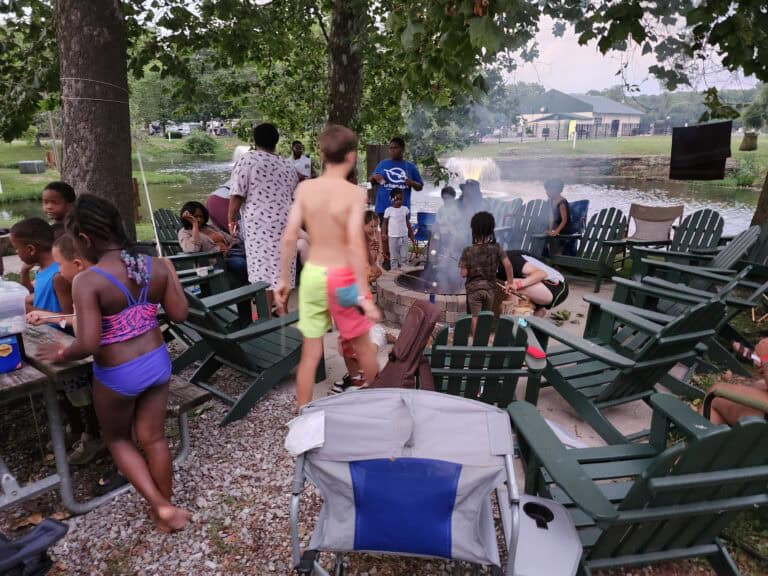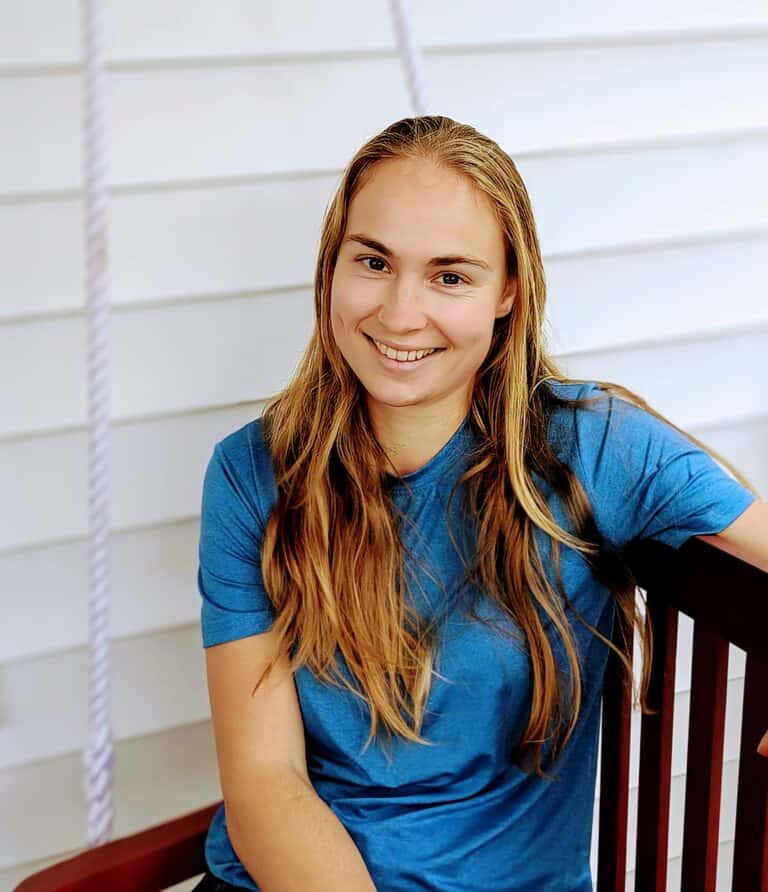The Case for Two Adults
After a decade working to house homeless mothers and their children, I’ve come to realize that more affordable housing for single parents is a limited solution to family homelessness.
By Mary Ellen Mitchell
It’s 5ish on a Wednesday night and my young boys are taunting the smart speaker, much to the dismay of my teenage daughter. They all yell at each other to be quiet. Chaos is overtaking my kitchen, while I convalesce with the flu, safely hidden under the weighted blanket; my husband is at a zoning meeting that’s set to last well into the evening. What’s striking to me about the that’s happening downstairs in my house right now is that it would be totally different if the second parent were home, awake and engaged. The carefully crafted chore chart would be semi-enforced; the announcement my daughter made of “I cooked burritos but eat them wherever because mom and dad aren’t around” would have been refuted in favor of our normal preference for tables and chairs. Whenever he or I attempt single parenting, we always come back with “bad idea.”
Recent reporting has confirmed my suspicions about the dismay of parenting alone: married mothers in two income families were the least lonely and the most financially secure as the weight of the pandemic bore down on American social structures from 2020-2022. I wasn’t surprised to read confirmation of this because, in addition to being a parent, I am the director of a family homeless shelter. Our primary demographic is pregnant and parenting women ages 18-24. I’m also not surprised to learn that solo moms, those that are without a cohabitating partner, are faring badly. These are the moms that land with us in the shelter. Before the pandemic they were lonely and broke, and after the pandemic, same.
I know these women, and I’ve followed some of their lives for almost a decade. In interviews that I’ve conducted, one guest expressed her hope for life moving forward this way: “In a real best case I’d have a partner to share bills and burdens with. I want a family. I want more kids with a partner. I want to be able to have somebody to fall back on.”
Loneliness eats away at women in our circle of shelter guests, but as a liberal I have long resisted the arguments of social conservatives who tout marriage as the solution to poverty. Schooled in “Housing First” and a general social service mentality that independence was the highest good, I regularly preached a gospel to our homeless guests that they should “depend on no one.”
It is our guests and those like them, poor women, who are parenting alone, engaging in a documented phenomenon of the “planned, unplanned” pregnancy. Whether they like it or not, they seem to have no one to depend on. Seventy percent of births to women without a high school diploma occur outside of marriage, whereas the same is true for less than ten percent of college-educated women. As Richard Reeves notes in his recent book, Of Boys and Men, this is something of a paradox: the women who have the highest level of economic independence are making childrearing work in marriage or cohabitation while those who most need a second income—not to mention a second child transporter, a second dishwasher, a second bedtime facilitator—are not.
While men may have let them down, our shelter guests haven’t given up on men. Perhaps the best illustration of this hope is the large number of women we’ve served that have more than one child, the later children with new men. Hope springs eternal.
But ultimately things often don’t work out with the men. Through my work at the shelter, I’ve met these hoped for partners and I see their shortcomings first-hand. Many of these fathers or alloparents were, themselves, the victims of neglect and abuse, adding to their inability to be committed and reliable partners. I get a glimpse of why single parenting might seem the best option available. That said, single parenting also doesn’t seem to work well, and we see women continue to struggle profoundly, even once we help them get into income-based apartments.
My husband and I spent the past decade advocating for affordable housing in Cincinnati. Coming from a place of faith rooted in service and heavily influenced by Democratic politics, in 2014 we co-founded Lydia’s House, a shelter that serves moms with a wraparound model and indefinite enrollment in our aftercare program. Noting the necessity of housing to move these solo moms and kids out of shelter, our organization began developing affordable units in 2016.
Since Lydia’s House entered tenuously into the world of low income land lording and the bigger conversation about what it would take to respond to the housing affordability crisis in our region (which, by the way, is one of the most affordable in the nation) rather than see an uptick in affordable family housing, the picture seems to get bleaker. Rents in our region are among the fastest rising in the nation. Public housing authorities are closing units, and many of their housing project communities are in bad shape. The most common product for creating subsidized housing, the Low Income Housing Tax Credit, is bureaucratically dense and fails to cover the full cost of development, meaning multiple sources of financing must be “stacked” to make the units affordable to the lowest income families.
When I jumped into the housing development and advocacy conversation seven years ago, it was from a place of idealism that we could work together as advocates and community developers to solve a huge deficit of family housing available for the very poorest families.
I now wonder if we’re even solving the right problem.
What if the family housing affordability crisis for able-bodied adults with children in our region could be greatly alleviated by simply adding a second adult—be it father, sister, grandmother, or friend—to the equation?
In late 2022 the Housing Advocacy group National Housing Coalition presented a study called “Paycheck to Paycheck” including this calculator which sorts housing options based on job type and typical pay. The argument they make effectively is that one low-skilled worker can’t afford a two-bedroom apartment in most regions, including affordable Cincinnati. However, use the calculator to try out very low-paid, low-skilled jobs, like hotel maid for instance, and double that income—and the housing affordability on a two-bedroom unit in Cincinnati suddenly works without subsidies.
Perhaps this is obvious to most readers, but for me it was an epiphany.
To make this point from another angle: Housing affordability at 30% AMI ($28, 650) in our region would dictate that a family of 4 could pay $716 a month in rent and utilities. This rent on a 2 bedroom is not available in the market. It requires government and philanthropic support. However if two adults worked at a fast food restaurant making $12 an hour, full time, 46 weeks a year they would earn $44,160. In this case, they could afford $965 a month in rent and $134 in utilities, even while holding a car payment of $500 a month. A quick search on the real estate tracking site, Yardi, shows 141 2 bedroom rentals within budget, in the market, available today, for this family. Two earners with two bedrooms make the numbers work, even at jobs that don’t require a high school diploma, and as we all know by looking at the “hiring” signs, these workers are in high demand.
I am not presenting a case for the model of two working adults sharing one unit of housing in order to undermine the case for creating new units of affordable housing for families, subsidized by the government and charity. Our organization currently owns twelve of these units and may add more. The few projects that go on line each year are vital, particularly as we are net losing apartment units in our region. There will always be solo parents, and there are situations, particularly for foster care age outs, where there are literally no other adults in their circle to invite in for rent-sharing. Subsidized housing is also needed for disabled parents.
Furthermore, asking women to live with abusers or have their children abused by men, for the sake of rent, is unacceptable.
Still, it’s clear that the small amount of affordable housing we can put on line each year is not a comprehensive solution to the social phenomenon of single adults with their children in need of separate 2+ bedroom housing units. Building enough housing to meet this demand is unrealistic, unsupported by our conservative legislature, and most importantly, often leaves women isolated with kids in siloed housing units, to their self-stated detriment.
A more human solution, and one that matches the tone of our current economy and long history of anthropology, is to live together. David Brooks made this argument eloquently in his essay “The Nuclear Family was a Mistake.” Ezra Klein doubled down on this recently in an interview with Dan Savage when he said “two people is too few to raise a family.” This resonates—it’s why I have chosen to raise my own children in the context of a larger community—but from where I stand, rebuilding robust social networks of extended clan and family for our shelter guests seems overwhelming and near impossible; adding one adult to the child rearing equation might be a more achievable place to start, and when the second adult assumes a parenting role, it could have exponential benefits for the housing-insecure mothers I know.
In many cases, research suggests it is the fathers of children who are the best and most sustainable option for cohabitation and rent sharing. Though our sample size is relatively small, this has been true at Lydia’s house: fathers last the longest and have the least drama with rent sharing. There are so many wins to be had if men could peacefully live with the women that they have children with, add to the household economy, share in child-rearing, and provide mutual salve for loneliness and purposelessness. While lifetime monogamy may be a stretch for many, for most of human history in most societies, couples staying together long enough to get their children to an age of self-sufficiency has been the norm, regardless of their particular affinity for one another. If not a father, though, I’m a firm believer that any safe second adult in house is an exponential benefit.
The problem is that our current paradigm, particularly the social service sector, government benefits structure, zoning and income based housing policy, disincentivizes co-housing, co-parenting, and bill-sharing. This “independence mentality” serves no one well. Instead, it undermines the ability of families to achieve the self-sufficiency and relationship stability that they want to have.
In one case in our circle, a mom with a broken leg refused to add her baby father to the lease, an act which would have allowed him unlimited “legal” nights in the apartment and increased her formal support in a very vulnerable situation but also would have raised her rent and potentially jeopardized her eligibility for Section 8 housing; she allowed him to stay from time to time but adamantly did not want his income reported, so sacrificed the relational support that would come with giving him legal tenancy.
If two adults together make it possible to alleviate homelessness, encourage work, and support kids, government has to stop disincentivizing the very path to stability. Government policy nudges; it ought to nudge people away from isolation and toward participation and relationship.
Better nudges might include less harsh benefits cliffs, universal benefits regardless of total adults in the household or even changing the structure of subsidies at the construction development level. Local government can use incentives like reduced parking requirements or increased density allowances to make 2-bedroom housing projects work at or near market rate rent, without requiring occupants to constantly fear increased payments with additional working adults added to the lease. A municipality offering the incentives to put these 2 bedrooms on line could require developers to accept Section 8, still allowing for the possibility of lower income and “solo parents” in these buildings while making two earners in a 2 bedroom the expected economic paradigm.
Even with systemic improvements, particular couples still have choices to make. I’m the child of divorced parents, so I realize that there’s no magic wand to wave to make relationships work when affinity is gone. Realizing that life and parenting was hard married, my parents knew life would be harder not married, especially as my mom didn’t have a college degree. My father often did extended periods of work in other cities; my mom took a night shift at her job doing airline reservations. They had little personal relationship that I remember, but the economic and child hand-off piece stayed intact for 20 years. My mom didn’t leave my dad until my sister and I were out of the house. Perhaps having experienced the functional utility of two adults agreeing to make things work for the sake of stability makes me believe in it all the more. I’m under no illusions that life would have been better if my parents separated earlier, and it certainly wasn’t for my younger brother, who was still home when they did.
On my refrigerator is a magnet quote “Life does not have to be Perfect to be Wonderful.” After a decade of accompanying single moms through shelter, applying for benefits, affordable housing, income cliffs, child-care debacles, and the bottom falling out again and again, I want to make my own magnet, “Partners don’t have to be perfect to be better than single parenting.”
The work to be done is to convince those adults that this is true, make the possibility more alluring, and find new ways to support couples as they do the often difficult work of parenting together. Because getting along is probably less difficult—and certainly more sustainable—than going it alone.
Mary Ellen Mitchell is the co-founder and co-director of Lydia’s House, a landlord, housing advocate, co parent of 3 children and community builder in the Norwood neighborhood of Greater Cincinnati.



